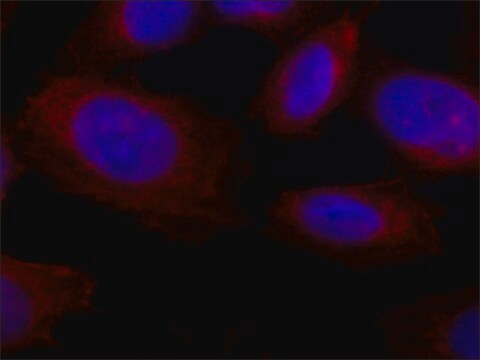推荐产品
生物源
rabbit
抗體表格
affinity isolated antibody
抗體產品種類
primary antibodies
無性繁殖
polyclonal
純化經由
affinity chromatography
物種活性
human, canine
物種活性(以同源性預測)
mouse (87%), dog, horse, rat (87%)
濃度
0.5 mg/mL
技術
immunoprecipitation (IP): suitable
western blot: suitable
同型
IgG
NCBI登錄號
UniProt登錄號
運輸包裝
wet ice
目標翻譯後修改
unmodified
基因資訊
human ... SUN2(25777)
一般說明
UNC84B (Protein UNC-84 homolog B or SUN2), is a single-pass nuclear envelope transmembrane protein responsible for nuclear migrations that are essential for development. UNC-84B has a predicted transmembrane domain and a C-terminal region with similarity to the S. pombe spindle pole body protein Sad1. UNC-84B interacts with RAB5A and is widely expressed, and highly expressed in the heart, lungs and muscles. UNC-84 may function to facilitate a nuclear-centrosomal interaction required for nuclear migration and anchorage.
特異性
This antibody recognizes Unc84B/SUN2 at the N-terminus.
免疫原
Epitope: N-terminus
KLH-conjugated linear peptide corresponding to human Unc84B/SUN2 at and around the N-terminus.
應用
Immunoprecipitation Analysis: 10 µg from a previous lot immunoprecipitated Unc84B/SUN2 from 500 µg of U2OS cell lysate.
Research Category
Epigenetics & Nuclear Function
Epigenetics & Nuclear Function
Research Sub Category
Transcription Factors
Transcription Factors
This Anti-Unc84B/SUN2 Antibody is validated for use in Immunoprecipitation and Western Blotting for the detection of Unc84B/SUN2.
品質
Evaluated by Western Blotting in U2OS cell lysate.
Western Blot (SNAP ID) Analysis: 1:250 dilution of this antibody detected Unc84B/SUN2 on 10 µg of U2OS cell lysate.
Western Blot (SNAP ID) Analysis: 1:250 dilution of this antibody detected Unc84B/SUN2 on 10 µg of U2OS cell lysate.
標靶描述
~80 kDa
外觀
Affinity purified
Purified rabbit polyclonal in buffer containing 0.1 M Tris-Glycine (pH 7.4, 150 mM NaCl) with 0.05% sodium azide.
儲存和穩定性
Stable for 1 year at 2-8°C from date of receipt.
分析報告
Control
U2OS cell lysate.
U2OS cell lysate.
免責聲明
Unless otherwise stated in our catalog or other company documentation accompanying the product(s), our products are intended for research use only and are not to be used for any other purpose, which includes but is not limited to, unauthorized commercial uses, in vitro diagnostic uses, ex vivo or in vivo therapeutic uses or any type of consumption or application to humans or animals.
未找到合适的产品?
试试我们的产品选型工具.
儲存類別代碼
12 - Non Combustible Liquids
水污染物質分類(WGK)
WGK 1
閃點(°F)
Not applicable
閃點(°C)
Not applicable
The leukocyte nuclear envelope proteome varies with cell activation and contains novel transmembrane proteins that affect genome architecture.
Korfali, N; Wilkie, GS; Swanson, SK; Srsen, V; Batrakou, DG; Fairley, EA; Malik et al.
Molecular and Cellular Proteomics null
Nadia Korfali et al.
Methods in molecular biology (Clifton, N.J.), 1411, 3-44 (2016-05-06)
Nuclei can be relatively easily extracted from homogenized liver due to the softness of the tissue and crudely separated from other cellular organelles by low-speed centrifugation due to the comparatively large size of nuclei. However, further purification is complicated by
Nanami Ueda et al.
Frontiers in cell and developmental biology, 10, 885859-885859 (2022-06-07)
The linker of nucleoskeleton and cytoskeleton (LINC) complex is composed of the inner nuclear membrane-spanning SUN proteins and the outer nuclear membrane-spanning nesprin proteins. The LINC complex physically connects the nucleus and plasma membrane via the actin cytoskeleton to perform
Nikolaj Zuleger et al.
Genome biology, 14(2), R14-R14 (2013-02-19)
Different cell types have distinctive patterns of chromosome positioning in the nucleus. Although ectopic affinity-tethering of specific loci can be used to relocate chromosomes to the nuclear periphery, endogenous nuclear envelope proteins that control such a mechanism in mammalian cells
Nadia Korfali et al.
Nucleus (Austin, Tex.), 3(6), 552-564 (2012-09-20)
One hypothesis to explain how mutations in the same nuclear envelope proteins yield pathologies focused in distinct tissues is that as yet unidentified tissue-specific partners mediate the disease pathologies. The nuclear envelope proteome was recently determined from leukocytes and muscle.
我们的科学家团队拥有各种研究领域经验,包括生命科学、材料科学、化学合成、色谱、分析及许多其他领域.
联系技术服务部门